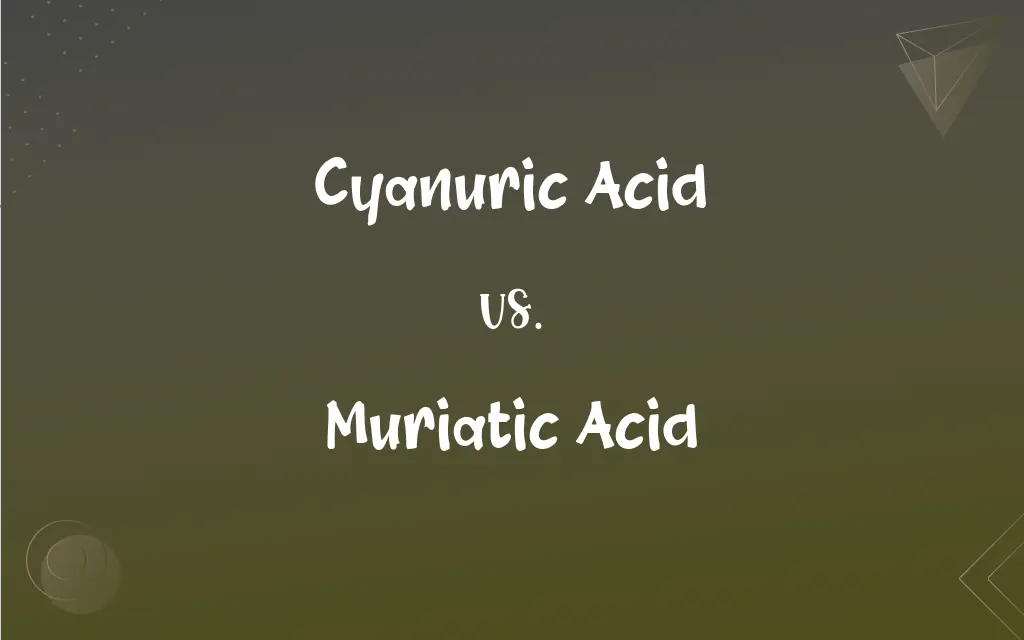Cyanuric Acid vs. Muriatic Acid: What's the Difference?
By Janet White || Published on December 29, 2023
Cyanuric acid stabilizes chlorine in pools, preventing rapid degradation from sunlight, whereas muriatic acid, a form of hydrochloric acid, is used to lower pH and alkalinity in pools.

Key Differences
Cyanuric acid functions primarily as a chlorine stabilizer in swimming pools, helping maintain effective chlorine levels. Muriatic acid, conversely, is employed for pH and alkalinity adjustment, reducing high levels to maintain pool water balance.
In terms of chemical structure, cyanuric acid is a triazine compound, known for its ring structure containing nitrogen and carbon atoms. Muriatic acid, on the other hand, is essentially hydrochloric acid in a diluted form, comprising hydrogen and chlorine atoms.
Cyanuric acid's role extends to protecting chlorine from ultraviolet (UV) light degradation, thus prolonging the effectiveness of chlorine in outdoor pools. Muriatic acid, in its capacity, is also used for cleaning purposes, effectively removing stains and scaling from pool surfaces.
Cyanuric acid is crucial for outdoor pools, it can lead to issues like chlorine lock if overused. Muriatic acid, with its corrosive nature, requires careful handling and storage to avoid damage to surfaces and harm to users.
Cyanuric acid is often added to chlorine products like dichlor and trichlor. Muriatic acid, being more general in application, finds use in various industries beyond pool maintenance, including the processing of leather and cleaning of masonry.
ADVERTISEMENT
Comparison Chart
Primary Use
Stabilizes chlorine in pools
Lowers pH and alkalinity in pools
Chemical Composition
Triazine compound (contains nitrogen and carbon)
Diluted hydrochloric acid (contains hydrogen and chlorine)
Role in Pool Maintenance
Protects chlorine from UV light degradation
Cleans pool surfaces, removes stains and scaling
Potential Issues
Can cause chlorine lock if overused
Corrosive, requires careful handling and storage
Broader Applications
Added to chlorine products like dichlor and trichlor
Used in leather processing and masonry cleaning
ADVERTISEMENT
Cyanuric Acid and Muriatic Acid Definitions
Cyanuric Acid
Cyanuric acid is often incorporated in chlorine tablets for pool maintenance.
The chlorine tablets we use contain cyanuric acid for added stability.
Muriatic Acid
Muriatic acid, a diluted hydrochloric acid, is used to balance pH in swimming pools.
We added muriatic acid to lower the high pH level of our pool water.
Cyanuric Acid
Cyanuric acid is a stabilizer in swimming pools to maintain chlorine effectiveness.
We added cyanuric acid to our pool to keep the chlorine levels steady.
Muriatic Acid
It is essential for reducing alkalinity in addition to pH levels in pool water.
To correct the alkalinity of our pool, we treated it with muriatic acid.
Cyanuric Acid
Cyanuric acid is essential for outdoor pools to reduce chlorine degradation by sunlight.
Our outdoor pool requires cyanuric acid to prevent the chlorine from breaking down in sunlight.
Muriatic Acid
Muriatic acid is known for its corrosive nature, requiring careful handling.
When using muriatic acid for pool maintenance, always wear protective gear.
Cyanuric Acid
It can lead to chlorine lock if its levels get too high in pool water.
We monitor cyanuric acid levels carefully to avoid chlorine lock in our pool.
Muriatic Acid
It serves as a cleaning agent, effectively removing stains and scaling in pools.
To clean the pool tiles, we applied muriatic acid to remove the tough stains.
Cyanuric Acid
It is a triazine compound, notable for its threefold symmetric ring structure.
The unique structure of cyanuric acid makes it effective in protecting chlorine.
Muriatic Acid
Beyond pools, it's used in industries like leather processing and masonry.
Muriatic acid is versatile, used not just in pools but also in masonry work.
FAQs
Is cyanuric acid safe for all types of pools?
Primarily for outdoor pools; indoor pools generally don't need it.
Can cyanuric acid cause any problems in pools?
Yes, high levels can lead to chlorine lock, reducing chlorine's effectiveness.
What is muriatic acid primarily used for?
Lowering pH and alkalinity in pool water, and as a cleaning agent.
Can cyanuric acid be mixed with other pool chemicals?
It should not be mixed directly; follow manufacturer’s guidelines.
Is muriatic acid dangerous?
Yes, it's corrosive and requires careful handling and proper storage.
Does cyanuric acid evaporate or degrade over time in pools?
It's relatively stable but can diminish over time and with water replacement.
Is cyanuric acid harmful to swimmers?
In normal levels, it's safe, but high concentrations can be irritating.
How often should cyanuric acid be added to pools?
It depends on chlorine levels and pool usage, typically checked monthly.
Can muriatic acid be used in any pool?
Yes, but with caution regarding the material of the pool surfaces.
What is cyanuric acid used for in pools?
It stabilizes chlorine levels, especially in outdoor pools.
How is muriatic acid applied in pool maintenance?
Diluted and added gradually, following safety guidelines.
Are there alternatives to muriatic acid for pH adjustment in pools?
Yes, sulfuric acid or sodium bisulfate can be used, but with different considerations.
Can cyanuric acid affect pool equipment?
Not directly, but imbalanced water can lead to equipment issues.
What precautions should be taken when handling muriatic acid?
Wear protective gear and ensure good ventilation.
Can muriatic acid be used for other purposes?
Yes, in various industries like leather processing and masonry.
What should be done in case of muriatic acid spillage?
Neutralize with baking soda or garden lime and clean up carefully.
How should muriatic acid be stored?
In a cool, well-ventilated area, away from incompatible substances.
Can muriatic acid affect pool liners or tiles?
Yes, it can damage certain materials if used improperly.
How quickly does muriatic acid work in pools?
Changes in pH can be noticed within hours of application.
Can high cyanuric acid levels be reduced?
Yes, by diluting pool water or partially draining and refilling.
About Author
Written by
Janet WhiteJanet White has been an esteemed writer and blogger for Difference Wiki. Holding a Master's degree in Science and Medical Journalism from the prestigious Boston University, she has consistently demonstrated her expertise and passion for her field. When she's not immersed in her work, Janet relishes her time exercising, delving into a good book, and cherishing moments with friends and family.






































































